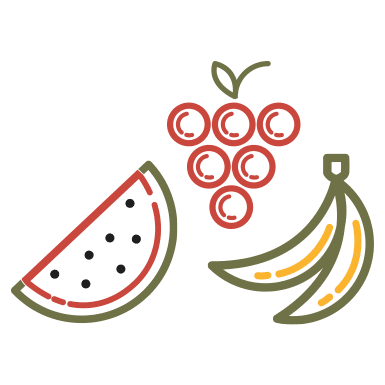
Improving access and fiscal performance of state programs to ensure a healthy foundation for all Coloradans
Human services programs ensure that Colorado communities have the building blocks for a prosperous future.
The Human Services Gap Map provides a window into how effectively Colorado is delivering the basic building blocks needed for lifelong health and well-being. The maps and graphs below present a county-by-county comparison of enrollment, allocations and costs for the following programs:
- Food Security: Supplemental Nutrition Assistance Program (SNAP), and the Special Supplemental Nutrition Program for Women, Infants and Children (WIC)
- Early Learning: Colorado Child Care Assistance Program (CCCAP)
- Financial Security: Colorado Works
- Health: Health First Colorado (Medicaid)
While these programs are funded and supervised by the state and federal government, Colorado counties are responsible for day-to-day administration.
Recognizing that each Colorado county is unique, the Human Services Gap Map is intended to spark a dialogue among human service directors, their staff, advocacy organizations and community leaders about the most effective strategies for closing gaps in enrollment vs. eligibility, allocation vs. spending, and improving the overall effectiveness and efficiency of our limited resources. Improving access to and administration of these programs will ensure Coloradans of all ages and zip codes can weather life’s storms and thrive, while also boosting our state’s economic health.
The map below provides county rankings of access to these human services programs. Counties with the highest rate of access among the eligible population in the county hold the top spots.
Click on a county to begin learning more about what’s happening in your community.
For a complete explanation of the data sources and methods, see Gap Map Methodology.
Human services gap #1:
Program access
The interactive graph below shows the gap between the number of Coloradans enrolled and the number estimated to be eligible for enrollment by county for food assistance (SNAP), nutrition assistance for women, infants and children (WIC), child care assistance (CCCAP), Colorado Works and Medicaid.
For many reasons, gaps in program access exist in all five programs across all counties. Some counties have a much larger gap between the people eligible for basic needs programs and those who actually receive assistance than other counties. The size of a gap may point to a missed opportunity to meet residents’ needs or more efficiently use available resources.
For child care assistance (CCCAP) and Colorado Works, the access gap is also a function of funding caps. This is a powerful visual example of how block-granted programs fall short in providing necessary services to help Americans build strong foundations: even if counties spend 100% of their program allocation, they seldom help even half of all eligible families in their communities.
County:
Caseload and Estimated Eligibility, 2015-19
:
, 2015-19
(Counties with an estimate of the population eligible for WIC have red bars)
Eligibility estimates were developed using census data.
For a complete explanation of data sources and methods, see Gap Map Methodology.
Human services gap #2:
Program allocations vs. actual spending
The State of Colorado appropriates money for public benefit programs that is divided among the counties. Allocations are based on a formula that considers historical caseloads, poverty rates and population. Counties generally have a high degree of discretion in how funds are spent within state and federal laws applicable to each program. This interactive graph shows the gap between the program allocations for CCCAP and Colorado Works versus the actual spending by county.
Big 10 Counties:
Percent of County Allocation Over or Under-Spent, SFY 15-19
County:
Allocation Expenditures and County Reserves, SFY 15-19
Some counties overspend their allocation while other counties underspend. Overspending may enable a county to more fully meet the community needs for assistance and may signal that the county needs additional state funds to support its residents.
Counties that underspend their allocation might leave money on the table that could help address the needs of their residents and stimulate the economy. Through a relatively complicated process, the state takes back unspent money from counties that did not spend their full allocation and redistributes it to the counties that are overspent.
From year to year, there is always some level of over- and underspending for many reasons. Caseloads fluctuate as community needs change making it difficult for county human services agencies to balance expenditures. Some communities face a shortage of child care providers and organizations to provide job placement, education, internships, and case management which has implications for counties fully expending their allocation. The data provided here is intended to be a resource for having these conversations about how to best manage county allocations and expenditures for these critical human services programs.
Human services gap #3:
Cost per case & benefits provided per administrative dollar spent
Eligibility, allocation and spending may provide clues about how counties can align their enrollment efforts or better manage their human services resources. But variability in administrative costs per case and benefits provided per administrative dollar spent might say more about a county’s efficiency than overall expenditures. The interactive graph below provides two measures of administrative and fiscal efficiency.
Cost per case is the amount of administrative dollars spent per case to enroll a client, and for some programs, to manage the administrative aspects of the case. A lower cost per case is an indicator of more efficient systems for enrolling and processing client cases. Larger counties may benefit from economies of scale on this measure.
Benefits provided per administrative dollar spent (abbreviated as ROI below) is a measure of how much in program benefits (i.e., cash, cash equivalent and/or services) are distributed per administrative dollar spent. This measure can be influenced by many factors, including efficiency of enrollment procedures, staffing costs driven by cost of living in a community, and the type of services provided. For example, administrative costs for the WIC program include nutrition education by registered dieticians, increasing the cost of the services provided especially compared to the cash benefits provided to participants.
Big 10 Counties:
,
County
,
Mapping the gaps in Medicaid and SNAP enrollment
To support thriving communities and individuals, we need to promote and align key human-service programs to support the health and well-being of all Coloradans. The interactive map below shows enrollment rates for Colorado’s two largest human services programs: Medicaid focused on access to health care and SNAP focused on access to food security. We provide an in-depth window into participation in these two vital programs for a few key reasons.
We know that food security reduces health care costs, improves health and education outcomes for children and stabilizes our state’s workforce. And yet, Colorado ranks 44th in the nation for SNAP enrollment. At the same time, enrollment in Medicaid has grown substantially across the state.
The data in this map provides a detailed picture of where enrollment in one program may be strong but is lagging in the other. Communities can use this information to begin asking questions about why enrollment is lagging, identify barriers to enrollment, and develop strategies and partnerships to improve access to food security and health care.
See the Food Assistance (SNAP) Benefit Calculator to get an estimate of your eligibility for food benefits.
then Search by Zip or Tract:
Gap Map solutions
With broad support from a diverse array of stakeholders, Senate Bill 190 was passed in 2016, which aimed to increase the efficiency and effectiveness of the state-supervised, county-administered food assistance program (SNAP).
The legislation clarified the expectations for administration of the program at the state and county levels, and created incentives for meeting and exceeding the federal standards for the timely and accurate processing of SNAP applications.
It also authorized a study of how Colorado’s 64 counties can implement best practices to increase their efficiency and effectiveness in delivering a number of public assistance programs and the support they will need from the state to do so.
The bill was passed unanimously by Colorado legislators and was signed into law by Gov. John Hickenlooper on June 1, 2016.
For more information on strategies being developed to end hunger for all Coloradans, see the Blueprint to End Hunger. It’s a multi-year plan developed by stakeholders across the state and includes efforts to maximize enrollment of income-eligible Coloradans in both WIC and SNAP.
See the Food Assistance (SNAP) Benefit Calculator to get an estimate of your eligibility for food benefits.
With enrollments in decline since 2009, nutrition assistance for women, infants and children (WIC) is focusing on identifying the potentially eligible population by census tract and county. This will enable prioritization of geographic areas with high levels of potentially eligible participants in order to strengthen outreach and referrals in specific areas.
Colorado WIC has partnered with the U.S. Census Bureau to receive detailed information on people who are eligible for WIC but not yet enrolled by census tract. This data, while valuable, will be somewhat outdated.
To rectify the situation, Colorado WIC is partnering with Medicaid to get monthly counts of enrolled pregnant women and children who are 0-5 years old to compare with counts of WIC clients as a real-time proxy measure for participation.
For more information on strategies being developed to end hunger for all Coloradans, see the Blueprint to End Hunger. It’s a multi-year plan developed by stakeholders across the state and includes efforts to maximize enrollment of income-eligible Coloradans in both WIC and SNAP.
The Colorado Child Care Assistance Program provides child care assistance to low-income families and caregivers living in Colorado in the form of reduced payments for child care. It is a program funded by the federal, state, and county governments and is administered by counties in Colorado. The share owed by parents/caregivers is determined on a sliding scale based on the family’s income.
State Department: Department of Early Childhood Education
Eligibility: Counties set eligibility for families separately, but must serve families with incomes at or below 185% of the Federal Poverty Limit. Families accepted to the program are no longer eligible once their income exceeds 85% of the state median income. Parents or caregivers must be employed, searching for work, or engaged in another approved activity to be eligible for CCCAP. Parents and caregivers enrolled in Colorado Works (Temporary Assistance to Needy Families or TANF) or in the child welfare system are also eligible to participate in CCCAP. Generally, CCCAP serves families with children under 13, although children as old as 19 may be eligible under certain circumstances.
Program Benefits: If a family is eligible for CCCAP and has income, they may likely have to pay a portion of their child’s or children’s child care costs each month. The amount that families owe is based on their gross income, number of household members, and the number of children in child care in the household.
Program Funding and Access: Colorado funds the CCCAP program using federal dollars it receives from the Child Care and Development Block Grant program. The state allocates federal and state funds to counties using a formula that takes into account factors like current caseloads and the number of eligible residents. Assistance is available until the county’s funds are spent, so the number of families that can be served is often a function of how much funding is available and the income and composition of the household that applies. It is not uncommon for counties to overspend or underspend their allocations of funds. The state reallocates unspent funds from counties who underspent to those who overspent. While underspending could indicate a problem with the way a county administers its CCCAP program, it could just as likely be a sign that there are few providers in the county who participate in CCCAP—or a lack of providers generally.
Statewide Program Access 2015-19: Over the study period of this report, an average of 10.8% of the population at or below 165% of FPL and younger than age 13 (i.e., the population who is likely to be eligible for CCCAP) were enrolled in CCCAP.
Colorado Works is the name given to Colorado’s program for Temporary Assistance to Needy Families or TANF. It is an employment program that supports families with dependent children on their path to self-sufficiency. Participants can receive cash assistance, schooling, workforce development and skills training.
State Department: Department of Human Services
Eligibility: Counties set eligibility for families separately, but must serve families with incomes at or below 185% of the Federal Poverty Limit. Families accepted to the program are no longer eligible once their income exceeds 85% of the state median income. Parents or caregivers must be employed, searching for work, or engaged in another approved activity to be eligible for CCCAP. Parents and caregivers enrolled in Colorado Works (Temporary Assistance to Needy Families or TANF) or in the child welfare system are also eligible to participate in CCCAP. Generally, CCCAP serves families with children under 13, although children as old as 19 may be eligible under certain circumstances.
Program Benefits: If a family is eligible for CCCAP and has income, they may likely have to pay a portion of their child’s or children’s child care costs each month. The amount that families owe is based on their gross income, number of household members, and the number of children in child care in the household.
Program Funding and Access: Colorado funds the CCCAP program using federal dollars it receives from the Child Care and Development Block Grant program. The state allocates federal and state funds to counties using a formula that takes into account factors like current caseloads and the number of eligible residents. Assistance is available until the county’s funds are spent, so the number of families that can be served is often a function of how much funding is available and the income and composition of the household that applies. It is not uncommon for counties to overspend or underspend their allocations of funds. The state reallocates unspent funds from counties who underspent to those who overspent. While underspending could indicate a problem with the way a county administers its CCCAP program, it could just as likely be a sign that there are few providers in the county who participate in CCCAP—or a lack of providers generally.
Statewide Program Access 2015-19: Over the study period of this report, an average of 10.8% of the population at or below 165% of FPL and younger than age 13 (i.e., the population who is likely to be eligible for CCCAP) were enrolled in CCCAP.
Medicaid recipients and administrators often face the challenge of “churn” – a word that describes the movement between health coverage programs due to fluctuations of income and household size. Unfortunately, churn often results in temporary loss of coverage when recipients’ statuses change, but it also has negative effects on health outcomes and increases administrative costs associated with enrolling and re-enrolling individuals into coverage programs.
To reduce churn and encourage better continuity of care, the Colorado Department of Health Care Policy and Financing, with the support of advocates, adopted a federal option that would allow recipients who are at risk of losing Medicaid due to seasonal, commission-based or self-employment income to annualize that income over the rest of the year.
For example, if a person is found ineligible for Medicaid based on monthly income due to seasonal work at a ski resort, projected income can be spread out over the remainder of the year and prevent the person from losing coverage. This saves the system administrative costs and prevents a lapse of coverage that could potentially affect the individual’s health.
The new rule went into effect in Colorado on June 31, 2016.
Human service programs
About the Gap Map
Originally developed by Colorado Center on Law and Policy in partnership with Hunger Free Colorado, the Gap Map provides a window into how effectively the State of Colorado is assisting low-income residents through our state’s most important public benefit programs. Our state’s counties are the entities that are responsible for administering most of these programs. Those that don’t rely on local partners, whether they be WIC Clinics or Public Housing Agencies. As federal programs, our Congress and national government play a large role in these programs too—often determining rules, such as eligibility criteria or funding levels.
This most recent update to the Gap Map is intended to spark a dialogue among administrators, policy makers, legislators, advocates, and participants at all levels of government about the most effective strategies and solutions for closing gaps in enrollment in efficient and cost-effective ways. Although we look at counties in this analysis, the outcomes—good or bad—captured in the Gap Map are not necessarily a reflection of the way a county administers these programs. Rather, it often reflects the outcome of a series of barriers and challenges, from lack of federal funding and complex federal rules and requirements to a scarcity of providers or county hiring challenges, that limit the ability of these programs to provide assistance to those who need it.
Read more here about the methodology used in updating the Gap Map and the data sources used in the analysis. As a general note, we limited our analysis to 2019 in order to maintain comparability across all years of the data. Starting in 2020, the federal and state government responses to the COVID-19 pandemic created temporary changes to these programs that do not reflect how these programs normally operate. In many cases, these changes made programs more generous or relaxed eligibility requirements but are now largely returning to pre-pandemic rules and requirements.





